Gas boiler for an apartment building: organization options and device features
What problems do residents of an apartment building often face in winter? First of all, it is a poor-quality heat supply. Hopelessness also saddens while waiting for the start of the inclusion of heating systems. A gas boiler for an apartment building will help maintain a constant temperature in each apartment and save on paying for services.
Residents are forced to freeze from the cold to the start date of the heating season. The need to pay a round sum monthly to pay for heating achieves the most persistent.
Installing a gas boiler on the roof will solve the heating problems once and for all. The main obstacles to resolving the issue of installing a gas boiler are related to obtaining permits from the administration and the acquisition of suitable equipment.
The content of the article:
Advantages of an autonomous gas boiler
Typically, an autonomous gas boiler room is equipped in apartment buildings in separate rooms. For these purposes, separate rooms on the roof are suitable.
They contain all the necessary equipment for the continuous operation of the heating system. The capacity of the installed equipment should be enough for heating radiators and heating water in the apartments of the whole house.
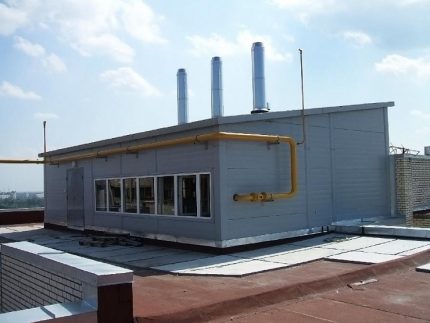
Such mini-boiler rooms are equipped with many modern appliances and a variety of devices. Autonomous systems use the most advanced heating technology. This allows you to use one boiler room even for several houses, which increases the profitability for residents several times.
There are several factors that determine the benefits of installing a roof gas boiler in apartment buildings.
First of all, this is a significant reduction in the distance from the heat generator to radiators and pipes in apartments. Due to this, heat losses during water circulation in the system are reduced. Rough estimates show that owners pay for heating an amount 30% higher than the real cost due to heat loss.
Residents who once installed a gas boiler room in the basement or on the roof of a multi-storey building note a real reduction in utility bills. Also, they are much less likely to encounter the need for frequent maintenance of systems: their repair, installation and reconstruction. Modern communications are of high quality and durability.
In connection with the shortening of the path that water must pass from the central energy carrier, the heating rate of the system increases. The temperature of batteries and hot water also increases on average. Although this is largely regulated by the setting of the gas boiler.
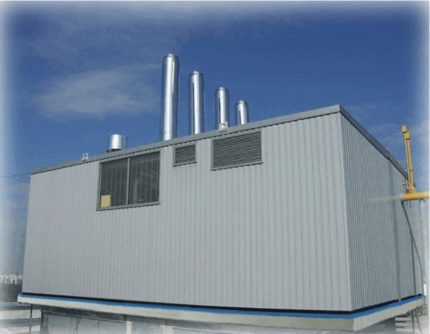
If we compare the central heating system with an autonomous one, then the second option wins in many respects. This is both efficiency and the rate of heating the water in the system.
In addition, central heating is switched on only after reaching certain temperatures. However, cold weather can hold for a long time until it reaches the required minimum. And the residents are forced to endure the cold and suffer.
With an autonomous system, it becomes possible to maintain the desired level of heat all year round and not depend on utilities. Thermal regulators are usually installed on radiators and circuits, allowing you to change the temperature depending on the needs of users. Sometimes setting a comfortable temperature allows you to save extra.
Disadvantages of modern heating systems
As with any heating system, the autonomous system has its drawbacks. Although they are much smaller in comparison with centralized. Due to the fact that gas autonomous boiler rooms are not widespread, it is quite problematic to get reliable equipment and all the nodes adjacent to it.
Therefore, the elements of the boiler house will cost customers a round sum. Despite the high level of comfort provided by the systems in question, not all developers are willing to pay a lot of money for this.
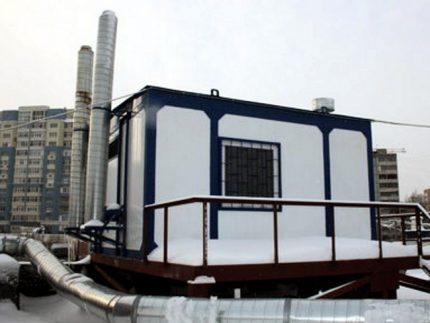
In addition, gas boiler houses must be placed in separate rooms or buildings. To do this, you need to allocate an area near the house, bring the roof to the required technical conditions, or install a block structure on the roof. All these decisions require the injection of additional resources either from the developer or from the general fund created by the tenants.
Gas heating systems emit decay products polluting it into the environment. Therefore, when installing boiler houses, it is necessary to provide for the installation of filtration systems. Cleaning devices must perform their functions sufficiently to comply with SNiP standards. This further increases the cost of purchasing equipment.
When building a new house, the developer has a choice: make an autonomous heating system or connect to the central highway. To crash into the highway you need to get a series of permits.Often, solving a problem requires a round sum of money. In addition, it will take several months to wait until the papers pass checks in all instances.
The high cost of joining existing networks, the difficulties in agreeing on this procedure, as well as the presence of a multitude of interferences that impede the rapid and efficient implementation of heating networks, reduce the attractiveness of autonomous systems for the developer.
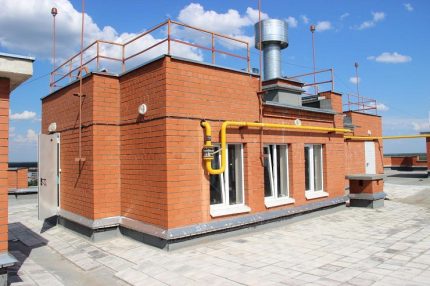
The installation of autonomous heating is also associated with a number of bureaucratic procedures. Both the initial implementation of the systems and the reconstruction with redevelopment have their own characteristic features. This is mainly due to the fact that you are going to use gas as a heating resource. All work with gas is strictly regulated by law.
Modern engineering developments effectively deal with a number of shortcomings. If it is necessary to heat only one house, an excellent option would be to place a block boiler room in the attic of the house. The attic becomes heated, and the residents of the last floor do not feel discomfort.
Such structures are developed in detail by engineers, have light weight and are installed on load-bearing walls. For such options, a flat roof option is required. This subtlety is usually taken into account at the design stage. Designers make calculations and pre-determine the place for the boiler room on the roof of the house.
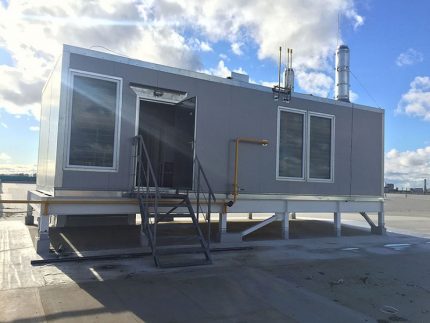
However, despite all the shortcomings, ultimately, the residents of the house will significantly improve their living conditions and get rid of discomfort. In addition to all the obvious advantages, autonomous systems have an increased level of security.
New systems are equipped with hazard and accident alarms. Varied sensors for gas boilers track a lot of indicators. In the event of a breakdown, the backup boiler and additional pumps are activated.
Classification and features of roof boiler rooms
If we talk about the heating of one particular house, then one of the best options for the location of the boiler room with a decentralized system is a flat roof. The SNiP text describes in detail all the permitted types of boiler rooms. In technical documents, special attention is paid to the requirements for heating equipment intended for installation on the ceiling.
The operation and installation of heating systems is negotiated separately for two types of structures: built-in and block-modular. Separate requirements, specifications and restrictions are presented for each option. Also, these two types of boiler rooms have their own characteristics: advantages and disadvantages.

Speaking about the advantages of installing an autonomous boiler on the roof, the following should be highlighted:
- There is no need to purchase a plot for a boiler room near the house;
- The hydraulic load to which boilers are exposed is reduced;
- There are no difficulties associated with the design calculation and chimneys;
- The task is much easier boiler room ventilation;
- Roof boiler rooms have no restrictions on the type of fuel, and the use of gas is one of the most profitable options.
The combination of advantages of installing the construction in question on the roofs determines the high frequency of application of this solution when planning autonomous heating.
Installation of a boiler room on the roof is only advisable if all the requirements and restrictions described in SNiP and PPB are taken into account. Next, we consider each of the available types of roof autonomous boiler.
Block-modular boiler rooms
Block or modular boiler rooms are compact in size and occupy a small area. Special blocks are brought to the site on the roof of the house, which are then connected into a finished and workable structure. Each element of the structure is equipped at the factory and equipped with all necessary equipment, which is connected to a common system.
After assembly, the heat station is ready for use. All necessary equipment is provided by the manufacturer and mounted in the module. It also provides for the availability of separate rooms for staff.
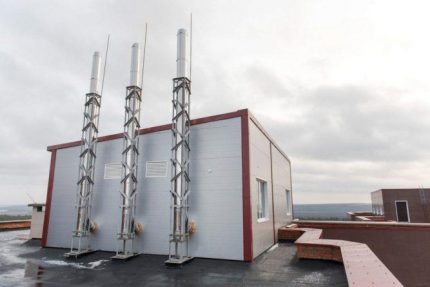
All equipment is selected to the required technical parameters and meets the standards. Blocks are usually equipped with high-quality insulation and a reliable ventilation system.
They may also have an attractive appearance and unusual design. During installation, the main task of specialists is to correctly connect all nodes and to check the operability of all elements.
Designers and engineers foresee the future installation of a boiler room for gas equipment on the roofs of multi-storey buildings. They minimize the weight and dimensions of the building frame. Usually, professionals assemble a boiler room in a few working days.
Installation of a modular roof boiler house consists of several stages. First of all, it is necessary to conduct an examination that will determine the bearing capacity of the building and the necessary procedures for its increase. If it turns out that it is necessary to strengthen the structure, then these procedures are carried out first.
Then install a platform that will rely on the supporting walls of the building. This is necessary for the stability of the unit. The next step is to create a fire-resistant coating under the gas boiler.
Usually, a concrete layer is poured to solve this problem. Safety should also be provided by installing railings around the perimeter of the roof. Soundproofing procedures are sometimes necessary.

Block boiler rooms are suitable for installation in buildings where there was originally central heating. However, for their arrangement it is necessary to purchase equipment with acceptable technical conditions and have a project.
Built-in rooftop boiler room
The layout of such boiler rooms fits in advance with the design documents. At the design stage, each element of the integrated roof boiler room is thoroughly described. Engineers calculate many different indicators and, based on the calculations, design a safe and efficient heating system.
Such indicators include the value of the load on the walls, the level of fire safety, the necessary boiler power, and others. Carrying out these calculations at the design stage is much easier and cheaper than remaking a centralized system into an autonomous one.
Along with the construction of the building, a number of events are being held. These include:
- soundproofing and suppression of noise emitted by heating equipment;
- protection of a boiler room against vibrations;
- providing protection against ignition, explosions and gas leaks.
Carrying out these procedures at the construction stage increases their effectiveness. Most houses were built under a centralized heating system, and only in the last 5-10 years, projects have built-in boiler houses.
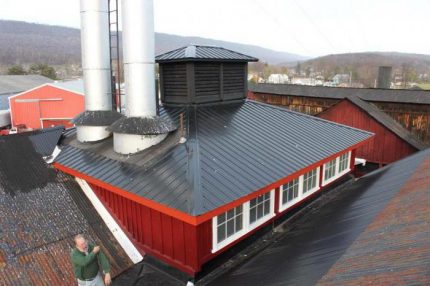
Designing built-in boiler rooms is done by experienced engineers. This is due to the need to comply with safety standards and legal regulations.
The advantages of such boiler houses include the lack of the need to spend money and time on capital construction. The customer also acquires a ready-made, tested and streamlined design that will heat the residents of the house for many years.
Thanks to modern developments, there is the possibility of almost complete control automation. This allows you to have a minimum number of staff. The environmentally friendly operation of the integrated gas boiler rooms is ensured by modern filtration systems.
Integrated or built-in boiler rooms are usually installed within a few days, which is very beneficial for the developer.
Autonomous boiler room device
Residents do not always buy a ready-made block boiler room. In some cases, the assistance of specialists in assembling an individual system is required.
The arrangement of a gas boiler plays a crucial role in its effective functioning. It is necessary to allocate a separate platform on the roof. There should be no flammable materials around the site.
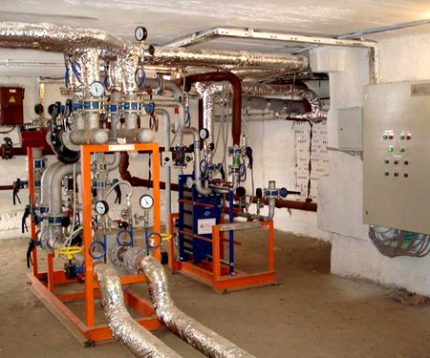
For safety reasons, boiler houses do not have more than two boilers: main and backup. Boilers are usually installed in the center of the room. This facilitates a systematic approach to systematic maintenance and repair.
The walls, and with them the entrance doors, are sheathed with non-combustible materials, for example, steel sheets. Floors are poured with concrete screed, then a non-combustible non-slip coating is placed on top of it.
The principle of operation of an autonomous gas boiler is to process natural gas. Thanks to automatic installations, an uninterrupted supply of fuel is ensured. The boiler protection system shuts off the gas supply if the sensors detect a leak or breakdown.
Key components of the boiler
The work of an autonomous boiler room is ensured by the presence of the following elements:
- Gas boilers for heating;
- Central gas line supplying gas to the system;
- Ventilation system and chimney that removes gas combustion products;
- Cold water and electricity supply system;
- Security system with a number of devices and sensors measuring various indicators;
- Built-in automation.
For heating an apartment building, the power of the wall unit is not enough, therefore, in this situation, floor gas boilers are used. Single-circuit boilers provide only heating of the coolant for delivery to radiators. Double circuit boilers simultaneously used for heating and for supplying hot water.
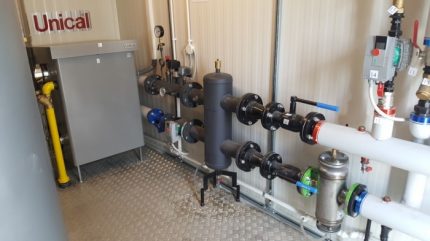
The boiler can be with a closed and open combustion chamber. For open type it is necessary to conduct a smoke channel. A closed type boilers are equipped coaxial chimney.
Thanks to modern technology, it became possible to almost completely remotely control the heating system while maintaining a high level of security.
The advantages of remote control include:
- The ability to customize the individual temperature for each apartment;
- Availability of a warning system about the values of the main indicators of equipment operation;
- Innovative weather-dependent control system.
Modern smart boilers have outdoor sensors that measure the temperature outside the house. If the air temperature drops, the boiler automatically starts to increase the water temperature in the system and vice versa.
What to consider?
Before arranging an autonomous boiler room, a number of factors must be taken into account. If a single-circuit gas boiler is purchased, then for the supply of hot water it will be necessary to install an accumulative type of water heater - a boiler.
For a branched system of an apartment building, a distribution manifold is required. Thanks to this device, constant pressure and temperature will be maintained in all circuits. Together with the collector set circulation pumps and water guns.
When the water in the system is heated, it expands. In order to maintain a constant pressure and compensate for expansion processes, expansion tank.

It is important to consider the layout of the chimney for the removal of gas decay products. To ensure security is installed safety valveas well as a mechanical or automatic air vent. Install a make-up tap in front of the heating system.
If automation is built into the system, then the need for human maintenance of the system will be reduced to scheduled checks of the system’s performance.
Installation of an autonomous gas boiler room has a number of nuances and difficulties. However, this version of the heating system for an apartment building has a number of comparative advantages in comparison with a centralized system.
The main problems that developers and future residents will have to deal with are obtaining permits from the administration and the gas industry to equip a gas boiler house.
It takes time and requires certain resources. Residents of houses with district heating will face even greater problems. First of all, they will have to get an agreement to disable old systems and get technical conditions for installing new ones. Far from always, utilities meet with such questions.
Conclusions and useful video on the topic
Overview of the roof boiler house TDK "New City":
The installation of a gas boiler in Svetly led to large cost savings:
The purchase of block boiler houses is one of the most profitable options for developers. Their delivery and installation takes a short time period, and the prices for equipment are acceptable. This allows you not to devote much time to this issue.
Residents who decide to install autonomous heating, protect themselves in the future from the shortcomings of centralized systems, guarantee themselves continuous heating and hot water all year round.
Please write comments in the block below, post a photo on the topic of the article, ask questions. Tell us about your experience in the design and / or operation of an autonomous gas boiler house in a multi-story building. It is possible that your advice will be extremely useful to site visitors.

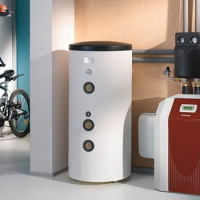 Boilers for heating a private house: types, features + how to choose the best
Boilers for heating a private house: types, features + how to choose the best  Types of gas burners for heating furnaces: device options and installation methods in the furnace
Types of gas burners for heating furnaces: device options and installation methods in the furnace 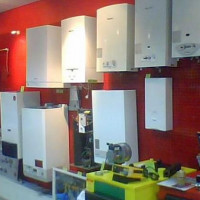 What is better double-circuit or single-circuit gas boiler: features of the device and operation
What is better double-circuit or single-circuit gas boiler: features of the device and operation 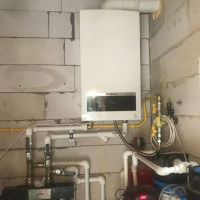 Grounding a gas boiler in a private house: standards, features of the device and checks
Grounding a gas boiler in a private house: standards, features of the device and checks 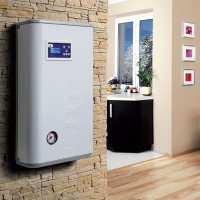 Electric boiler for heating a private house: an overview of the 15 best models of electric boilers
Electric boiler for heating a private house: an overview of the 15 best models of electric boilers 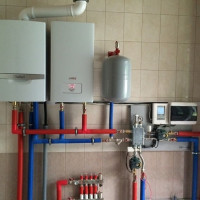 Gas and electric boiler in one system: features of the assembly of a parallel circuit
Gas and electric boiler in one system: features of the assembly of a parallel circuit  How much does it cost to connect gas to a private house: the price of organizing gas supply
How much does it cost to connect gas to a private house: the price of organizing gas supply  The best washing machines with dryer: model rating and customer tips
The best washing machines with dryer: model rating and customer tips  What is the color temperature of light and the nuances of choosing the temperature of the lamps to suit your needs
What is the color temperature of light and the nuances of choosing the temperature of the lamps to suit your needs  Replacement of a geyser in an apartment: replacement paperwork + basic norms and requirements
Replacement of a geyser in an apartment: replacement paperwork + basic norms and requirements